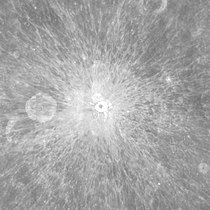
Tycho is a prominent lunar impact crater located in the southern lunar highlands, named after the Danish astronomer Tycho Brahe (1546–1601). It is estimated to be 108 million years old.

The lunar geological timescale divides the history of Earth's Moon into five generally recognized periods: the Copernican, Eratosthenian, Imbrian, Nectarian, and Pre-Nectarian. The boundaries of this time scale are related to large impact events that have modified the lunar surface, changes in crater formation through time, and the size-frequency distribution of craters superposed on geological units. The absolute ages for these periods have been constrained by radiometric dating of samples obtained from the lunar surface. However, there is still much debate concerning the ages of certain key events, because correlating lunar regolith samples with geological units on the Moon is difficult, and most lunar radiometric ages have been highly affected by an intense history of bombardment.

The Copernican Period in the lunar geologic timescale runs from approximately 1.1 billion years ago to the present day. The base of the Copernican period is defined by impact craters that possess bright optically immature ray systems. The crater Copernicus is a prominent example of rayed crater, but it does not mark the base of the Copernican period.

Giordano Bruno is a 22-kilometre (14 mi) lunar impact crater on the far side of the Moon, just beyond the northeastern limb. It lies in an area that can be viewed during a favorable libration, although the area is viewed from the side and not much detail can be seen. It lies between the craters Harkhebi to the northwest and Szilard to the southeast.
Copernicus is a lunar impact crater located in eastern Oceanus Procellarum. It was named after the astronomer Nicolaus Copernicus. It typifies craters that formed during the Copernican period in that it has a prominent ray system. It may have been created by debris from the breakup of the parent body of asteroid 495 Eulalia 800 million years ago.

Aristarchus is a lunar impact crater that lies in the northwest part of the Moon's near side. It is considered the brightest of the large formations on the lunar surface, with an albedo nearly double that of most lunar features. The feature is bright enough to be visible to the naked eye, and displays unusually bright features when viewed through a large telescope. It is also readily identified when most of the lunar surface is illuminated by earthshine. The crater is deeper than the Grand Canyon.

Ejecta are particles ejected from an area. In volcanology, in particular, the term refers to particles including pyroclastic materials (tephra) that came out of a volcanic explosion and magma eruption volcanic vent, or crater, has traveled through the air or under water, and fell back on the ground surface or on the ocean floor.

Proclus is a young lunar impact crater located to the west of the Mare Crisium, on the east shore of the Palus Somni. Its diameter is 27 km. It was named after 5th century Greek mathematician, astronomer and philosopher Proclus.
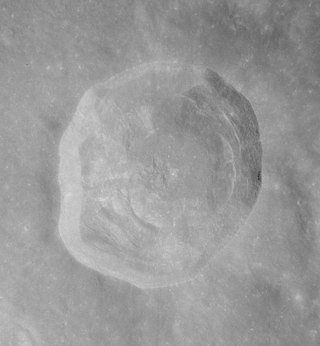
Lalande is a small lunar impact crater that lies in the central part of the visible Moon, on the eastern edge of Mare Insularum. It was named after French astronomer Jérôme Lalande. The crater is surrounded by a high-albedo area of ejecta that extends into a ray system with a maximum radius of over 300 kilometers. The interior wall has a terrace system, and there is a small central rise at the midpoint of the floor. It was formed during the Copernican period of the moon extending from 1.1 billion years ago to the present. Its young age is indicated by the bright rays of ejecta surrounding the crater, its sharp features, and the relative lack of later impacts in its interior. The rays of ejecta from Lalande overlay the ejecta rays from Copernicus Crater, meaning it is younger than Copernicus, and thus no more than 800 million years old.

The geology of the Moon is quite different from that of Earth. The Moon lacks a true atmosphere, and the absence of free oxygen and water eliminates erosion due to weather. Instead, the surface is eroded much more slowly through the bombardment of the lunar surface by micrometeorites. It does not have any known form of plate tectonics, it has a lower gravity, and because of its small size, it cooled faster. In addition to impacts, the geomorphology of the lunar surface has been shaped by volcanism, which is now thought to have ended less than 50 million years ago. The Moon is a differentiated body, with a crust, mantle, and core.

An ejecta blanket is a generally symmetrical apron of ejecta that surrounds an impact crater; it is layered thickly at the crater's rim and thin to discontinuous at the blanket's outer edge. The impact cratering is one of the basic surface formation mechanisms of the solar system bodies and the formation and emplacement of ejecta blankets are the fundamental characteristics associated with impact cratering event. The ejecta materials are considered as the transported materials beyond the transient cavity formed during impact cratering regardless of the state of the target materials.

The geology of Mars is the scientific study of the surface, crust, and interior of the planet Mars. It emphasizes the composition, structure, history, and physical processes that shape the planet. It is analogous to the field of terrestrial geology. In planetary science, the term geology is used in its broadest sense to mean the study of the solid parts of planets and moons. The term incorporates aspects of geophysics, geochemistry, mineralogy, geodesy, and cartography. A neologism, areology, from the Greek word Arēs (Mars), sometimes appears as a synonym for Mars's geology in the popular media and works of science fiction. The term areology is also used by the Areological Society.

The geology of solar terrestrial planets mainly deals with the geological aspects of the four terrestrial planets of the Solar System – Mercury, Venus, Earth, and Mars – and one terrestrial dwarf planet: Ceres. Earth is the only terrestrial planet known to have an active hydrosphere.
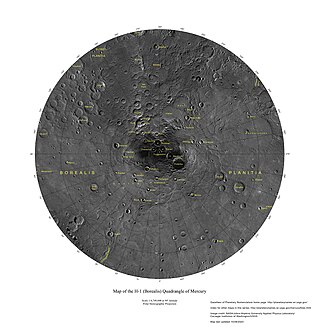
The Borealis quadrangle is a quadrangle on Mercury surrounding the north pole down to 65° latitude. It was mapped in its entirety by the MESSENGER spacecraft, which orbited the planet from 2008 to 2015, excluding areas of permanent shadow near the north pole. Only approximately 25% of the quadrangle was imaged by the Mariner 10 spacecraft during its flybys in 1974 and 1975. The quadrangle is now called H-1.

The Kuiper quadrangle, located in a heavily cratered region of Mercury, includes the young, 55-km-diameter crater Kuiper, which has the highest albedo recorded on the planet, and the small crater Hun Kal, which is the principal reference point for Mercurian longitude. Impact craters and basins, their numerous secondary craters, and heavily to lightly cratered plains are the characteristic landforms of the region. At least six multiringed basins ranging from 150 km to 440 km in diameter are present. Inasmuch as multiringed basins occur widely on that part of Mercury photographed by Mariner 10, as well as on the Moon and Mars, they offer a potentially valuable basis for comparison between these planetary bodies.

Zunil is an impact crater near the Cerberus Fossae on Mars, with a diameter of 10.26 kilometres. It is named after the town of Zunil in Guatemala. The crater is located in the Elysium quadrangle. Visible in images from the Viking 1 and Viking 2 Mars orbiters in the 1970s, Zunil was subsequently imaged at higher resolution for the first time by the Mars Global Surveyor (MGS) Mars Orbiter Camera (MOC) in 2000.

The Elysium quadrangle is one of a series of 30 quadrangle maps of Mars used by the United States Geological Survey (USGS) Astrogeology Research Program. The Elysium quadrangle is also referred to as MC-15.
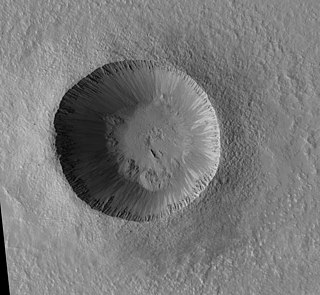
Zumba is a very young crater on Mars, located in the Phoenicis Lacus quadrangle at 28.68 South and 133.18 West. It measures approximately 2.93 kilometres (1.82 mi) in diameter and was named after the town of Zumba in Ecuador. The name was adopted by IAU's Working Group for Planetary System Nomenclature in 2006.

Taurus–Littrow is a lunar valley located on the near side at the coordinates 20.0°N 31.0°E. It served as the landing site for the American Apollo 17 mission in December 1972, the last crewed mission to the Moon. The valley is located on the southeastern edge of Mare Serenitatis along a ring of mountains formed between 3.8 and 3.9 billion years ago when a large object impacted the Moon, forming the Serenitatis basin and pushing rock outward and upward.
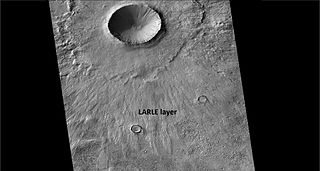
A low-aspect-ratio layered ejecta crater is a class of impact crater found on the planet Mars. This class of impact craters was discovered by Northern Arizona University scientist Professor Nadine Barlow and Dr. Joseph Boyce from the University of Hawaii in October 2013. Barlow described this class of craters as having a "thin-layered outer deposit" surpassing "the typical range of ejecta". "The combination helps vaporize the materials and create a base flow surge. The low aspect ratio refers to how thin the deposits are relative to the area they cover", Barlow said. The scientists used data from continuing reconnaissance of Mars using the old Mars Odyssey orbiter and the Mars Reconnaissance Orbiter. They discovered 139 LARLE craters ranging in diameter from 1.0 to 12.2 km, with 97% of the LARLE craters found poleward of 35N and 40S. The remaining 3% mainly traced in the equatorial Medusae Fossae Formation.




